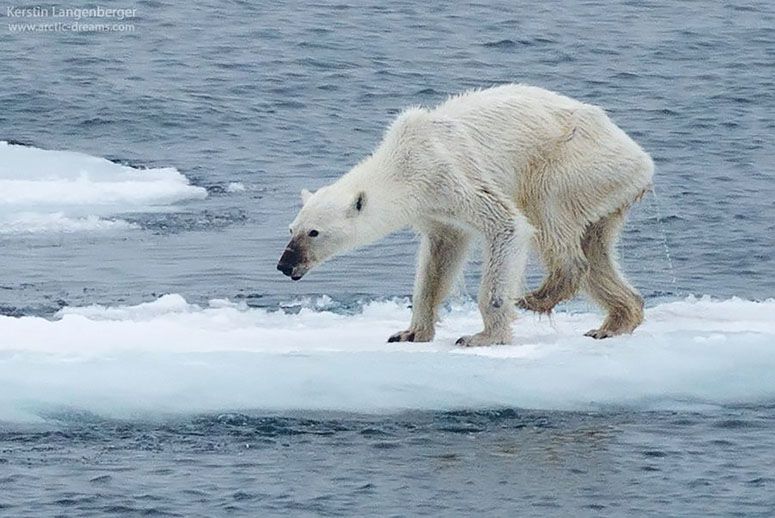Finding middle ground on climate change
A starving polar bear walks alone on sheet of ice.
June 22, 2021
Pictures of polar bears on floating sheets of ice have caused many to become invested in the climate change discussion. Some believe the changes made to the arctic habitat have been devastating, but others say the damage is overblown.
One of the more discussed matters of climate change is the melting of glaciers and the abnormal warmth in the arctic.
“Antarctica hit a peak temperature of 64.9° F this February, which really shows the crisis that we’re in,” freshman Braeden Dunham said.
Dunham states that our carbon emissions are the problem. According to Climate.gov, carbon and other greenhouse gases trap additional heat in the earth which is causing an increase in temperatures.
“I think that we really need to take more energy efficient methods,” said Dunham. “We need to move to nuclear energy which is way more carbon efficient.”
(Nuclear) Thorium mining is intended to take the place of uranium mining. According to NPR, thorium is much more abundant than uranium and creates a much better and more efficient fuel source. Though creating these reactors could come at a steep cost. According to windpowerengineering.com, the cost of the two reactors for the Vogtle Engineering Plant in Georgia was $14 billion.
“It (the increase in temperature) is actually based on latitude and the poleward transport of energy,” freshman Andrew Hibbitts said.
According to Britannica, the poleward transport of energy is the displacement of heat from the Indian and Pacific Ocean to higher latitudes to be given to the atmosphere which increases the temperature of the earth in the north poles and melts the ice.
Rising sea levels have been another prevalent topic within climate change. According to NASA, this is because greenhouse gases trap heat, 90% of that heat gets absorbed by the ocean which expands water molecules and rises the sea level. According to an Intergovernmental Panel on Climate Change (or IPCC) report, sea levels are rising at an average of 3.6 millimeters per year.
“I think we have more time,” Hibbitts said, talking about when to take action. “[The sea level is] going at a consistent manner so we know when to take action, it’s not like this wasn’t predicted.”
In 1990, IPCC predicted that sea level rise would accelerate to somewhere between 2.0 mm per year and 7.3 mm per year. However, some believe that sea level rise is more urgent and that now is the time to take action.
“We’ve seen increases in hurricanes since the 70’s and 80’s. This is for the most part because of sea level rise,” Dunham said. “Places like Puerto Rico, Florida, The Cayman Islands and the Bahamas [are] all being negatively affected by these hurricanes.”
To mitigate hurricanes, Dunham recommends trying more renewable forms of energy. According to “Debating Science” by students at the University of Massachusetts Amherst, carbon emissions trap heat in our atmosphere which is increasing evaporation causing a higher moisture content creating stronger storms.
“We need to move to nuclear energy, which is way more carbon efficient, and then slowly move into solar and wind,” Dunham said.
In the issue of carbon emissions, scientists often talk about “carbon neutral” and “carbon zero.” Carbon neutral means that the carbon intake is the same as our carbon emissions. Carbon zero means that there are absolutely no carbon emissions. Many figures in today’s society such as Bill Gates have been advocating for the world to become carbon zero.
“Carbon Zero is pretty much impossible,” said Dunham. “Especially because places like China and Russia have no regulations.”
According to Climate Tracker, in September 2020 Chinese President Xi Jinping announced their goal to be carbon neutral before 2060, though their carbon emissions are still consistently rising. Both Dunham and Hibbitts seem to be in agreement that carbon neutral is possible, but getting there by 2050 was going to be difficult.
“I think carbon neutral is more fair,” Hibbitts said. “I wouldn’t say probable, but it can be done. It’s all relative to the action we take.”
Due to an increase in wildfires in the last decade, particularly in California and the Amazon, another discussion has been opened about whether or not this increase is as a result of climate change.
“Forest fires are caused by human activity,” Dunham said. “It’s because of climate change that they grew to be that significant.”
Dunham specifically states the forest fires are often caused by the dryness in the environment according to E&E News. While climate change is likely to be a major factor, human activity is also a common cause.
Another aspect of climate change that humans have left their mark on is the ozone layer. According to National Geographic, the ozone layer is a layer of our atmosphere found in the stratosphere and is responsible for absorbing intense ultraviolet radiation which can be harmful to humans.
“I don’t think [the ozone hole] is as important as people think it is,” Dunham said. “It’s definitely getting better.”
According to the UN this is true, as it states the ozone layer is repairing itself 1-3% every 10 years.
“I don’t think we should interact with it [the ozone layer] and see what happens in the years to come,” Hibbitts said.
The question now being asked is what is the future of the climate change argument and what the next steps are.
“I don’t like to try to force people to take in a certain ideology,” said Hibbitts. “Look at the facts and come up with your own opinion.”



